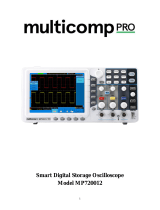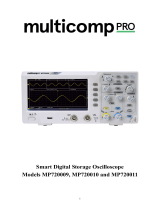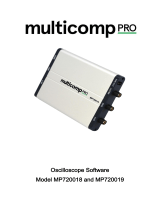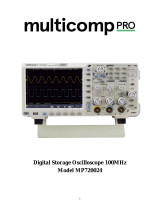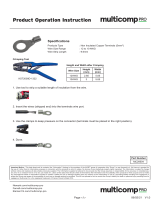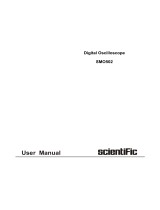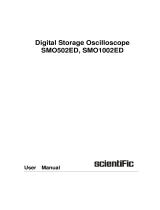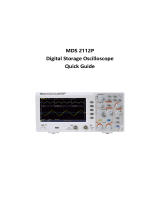Page is loading ...

i
MP720854 Four-Channel Series
Digital Storage Oscilloscopes
User Manual

ii
Table of Contents
1. General Safety Requirements .......................................................................................... 1
2. Safety Terms and Symbols ............................................................................................... 2
3. Junior User Guidebook ................................................................................................... 4
Introduction to the Structure of the Oscilloscope ..................................................................... 5
Front Panel ............................................................................................................................................... 5
Rear Panel ................................................................................................................................................ 6
Control Area ............................................................................................................................................. 7
User Interface Introduction ........................................................................................................ 8
How to Implement the General Inspection ............................................................................. 10
How to Implement the Function Inspection ............................................................................ 10
How to Implement the Probe Compensation .......................................................................... 11
How to Set the Probe Attenuation Coefficient ........................................................................ 12
How to Use the Probe Safely ..................................................................................................... 13
How to Implement Self-calibration .......................................................................................... 13
Introduction to the Vertical System ......................................................................................... 14
Introduction to the Horizontal System .................................................................................... 15
Introduction to the Trigger System ......................................................................................... 16
Touchscreen Controls ............................................................................................................... 16
4. Advanced User Guidebook ............................................................................................ 22
How to Set the Vertical System ................................................................................................ 23
Use Mathematical Manipulation Function .............................................................................. 25
Waveform math .................................................................................................................................... 26
User defined function ............................................................................................................................. 27
Digital Filter ........................................................................................................................................... 27
Using FFT function ................................................................................................................................ 28
Use Vertical Position and Scale Controls ................................................................................ 33
How to Set the Horizontal System............................................................................................ 34
Waveform Horizontal Zooming ............................................................................................................. 34
Magnifier (For specific models) ............................................................................................................. 35
How to Set the Trigger/Decoding System ................................................................................ 37
Single Trigger ......................................................................................................................................... 37
Logic Trigger .......................................................................................................................................... 46
Bus Trigger ............................................................................................................................................. 47
Bus Decoding ......................................................................................................................................... 53
How to Operate the Function Menu ........................................................................................ 58
How to Implement Sampling Setup ....................................................................................................... 58

iii
How to Set the Display System .............................................................................................................. 59
How to Save and Recall a Waveform ..................................................................................................... 62
How to Record/Playback Waveforms .................................................................................................... 69
How to Clone and Recall a waveform .................................................................................................... 73
How to Implement the Auxiliary System Function Setting .................................................................... 78
How to Update your Instrument Firmware ............................................................................................. 81
How to Measure Automatically .............................................................................................................. 82
How to Measure with Cursors ................................................................................................................ 87
How to Use Autoscale ............................................................................................................................ 90
How to Use Built-in Help ....................................................................................................................... 91
How to Use Executive Buttons............................................................................................................... 92
How to Print the Screen Image ............................................................................................................... 94
7. Communication with PC ............................................................................................... 95
Using USB Port .......................................................................................................................... 95
Using LAN Port ......................................................................................................................... 95
Connect directly ..................................................................................................................................... 95
Connect through a router ........................................................................................................................ 97
9. Demonstration ............................................................................................................. 101
Example 1: Measurement a Simple Signal ............................................................................ 101
Example 2: Gain of a Amplifier in a Metering Circuit ........................................................ 102
Example 3: Capturing a Single Signal ................................................................................... 103
Example 4: Analyze the Details of a Signal ........................................................................... 104
Example 5: Application of X-Y Function .............................................................................. 106
Example 6: Video Signal Trigger ........................................................................................... 107
10. Troubleshooting ......................................................................................................... 109
11. Technical Specifications ............................................................................................. 110
Oscilloscope .............................................................................................................................. 110
Trigger .................................................................................................................................................. 113
General Technical Specifications ........................................................................................... 114
12. Appendix ..................................................................................................................... 116
Appendix A: Enclosure ........................................................................................................... 116
Appendix B: General Care and Cleaning .............................................................................. 116
Appendix C: Battery Using Guide ......................................................................................... 117

Multicomp-pro
1
1. General Safety Requirements
Before use, please read the following safety precautions to avoid any possible bodily
injury and to prevent this product or any other connected products from damage. In
order to avoid any contingent danger, ensure this product is only used within the
range specified.
Only the qualified technicians can implement the maintenance.
To avoid Fire or Personal Injury:
Connect the probe correctly. The grounding end of the probe corresponds to the
grounding phase. Please don't connect the grounding end to the positive phase.
Use Proper Power Cord. Use only the power cord supplied with the product and
certified to use in your country.
Connect or Disconnect Correctly. When the probe or test lead is connected to a
voltage source, please do not connect and disconnect the probe or test lead at random.
Product Grounded. This instrument is grounded through the power cord grounding
conductor. To avoid electric shock, the grounding conductor must be grounded. The
product must be grounded properly before any connection with its input or output
terminal.
When powered by AC power, it is not allowed to measure AC power source
directly, because the testing ground and power cord ground conductor are
connected together, otherwise, it will cause short circuit.
When powered by battery, the product must ground connection. To avoid electric
shock, there must be a ground wire connect between ground and the ground port
(on the back of product panel).
Check all Terminal Ratings. To avoid fire or shock hazard, check all ratings and
markers of this product. Refer to the user's manual for more information about ratings
before connecting to the instrument.
Do not operate without covers. Do not operate the instrument with covers or panels
removed.
Use Proper Fuse. Use only the specified type and rating fuse for this instrument.
Avoid exposed circuit. Do not touch exposed junctions and components when the
instrument is powered.
Do not operate if in any doubt. If you suspect damage occurs to the instrument, have
it inspected by qualified service personnel before further operations.
Use your Oscilloscope in a well-ventilated area. Make sure the instrument installed
with proper ventilation, refer to the user manual for more details.
Do not operate in wet conditions.
Do not operate in an explosive atmosphere.
Keep product surfaces clean and dry.

Multicomp-pro
2
2. Safety Terms and Symbols
Safety Terms
Terms in this manual. The following terms may appear in this manual:
Warning: Warning indicates the conditions or practices that could result in
injury or loss of life.
Caution: Caution indicates the conditions or practices that could result in
damage to this product or other property.
Terms on the product. The following terms may appear on this product:
Danger: It indicates an injury or hazard may immediately happen.
Warning: It indicates an injury or hazard may be accessible potentially.
Caution: It indicates a potential damage to the instrument or other property might occur.
Safety Symbols
Symbols on the product. The following symbol may appear on the product:
Hazardous Voltage
Refer to Manual
Protective Earth Terminal
Chassis Ground
Test Ground
To avoid body damage and prevent product and connected equipment damage, carefully
read the following safety information before using the test tool. This product can only be
used in the specified applications.
Warning:
The four channels of the oscilloscope are not electrically isolated. The channels
should adopt a common ground during measuring. To prevent short circuits, the 2
probe grounds must not be connected to 2 different non-isolated DC levels.

Multicomp-pro
3
The diagram of the oscilloscope ground wire connection:
Ground Clip
Signal Input
Oscilloscope Electrical OutletProbe
Power Cord
The diagram of the ground wire connection when the battery-powered oscilloscope is
connected to the AC-powered PC through the ports:
Ground Clip
Signal Input
Oscilloscope
(Battery-power)
PC Electrical Outlet
Probe
USB/VGA/COM/
LAN Cable
It is not allowed to measure AC power when the oscilloscope is AC powered, or when
the battery-powered oscilloscope is connected to the AC-powered PC through the
ports.
Warning:
To avoid fire or electrical shock
, when the oscilloscope input signal
connected
is more than
42V peak (30Vrms) or on circuits of more than
4800VA
, please take note of below items:
Only use accessory insulated voltage probes and test lead.
Check the accessories such as probe before use and replace it if
there are any damages.
Remove probes, test leads and other accessories immediately after
use.
Remove USB cable which connects oscilloscope and computer.
Do not apply input voltages above the rating of the instrument
because the probe tip voltage will directly transmit to the
oscilloscope. Use with caution when the probe is set as 1:1.
Do not use exposed metal BNC or banana plug connectors.
Do not insert metal objects into connectors.

Multicomp-pro
4
3. Junior User Guidebook
This chapter deals with the following topics mainly:
Introduction to the structure of the oscilloscope
Introduction to the user interface
How to implement the general inspection
How to implement the function inspection
How to make a probe compensation
How to set the probe attenuation coefficient
How to use the probe safely
How to implement an self-calibration
Introduction to the vertical system
Introduction to the horizontal system
Introduction to the trigger system
Touchscreen Contro

Multicomp-pro
5
Introduction to the Structure of the Oscilloscope
This chapter makes a simple description of the operation and function of the front panel of
the oscilloscope, enabling you to be familiar with the use of the oscilloscope in the
shortest time.
Front Panel
The front panel has controls and function buttons. The 5 buttons in the column on the right
side of the display screen or in the row under the display screen are menu selection
buttons, through which, you can set the different options for the current menu. The other
buttons are function buttons, through which, you can enter different function menus or
obtain a specific function application directly.
10
3
54
98
1
6
2
7
Figure 3-1 Front panel
1. Display area
2. Select the right menu item
3. Control (button and control) area
4. Probe Compensation: Measurement signal (3.3V/1kHz) output.
5. Input connectors of four channels
6. Remove the left and right menu
7. Select the bottom menu item
8. Copy button: You can save the waveform by just pressing this button in any user
interface.

Multicomp-pro
6
9. USB Host port: It is used to transfer data when external USB equipment connects to
the oscilloscope regarded as "host device". For example: Saving the waveform to
USB flash disk needs to use this port.
10. Power on/off
Rear Panel
3
10 987
12
11
1 2
6
4
5
Figure 3-2 Rear Panel
1. Handle
2. Air vents
3. AC power input jack
4. Fuse
5. Foot stool: Adjust the tilt angle of the oscilloscope.
6. VGA port: To connect the oscilloscope with a monitor or a projector as VGA output
7. LAN port: the network port which can be used to connect with PC.
8. USB Device port: It is used to transfer data when external USB equipment connects to
the oscilloscope regarded as "slave device". For example: to use this port when
connect PC to the oscilloscope by USB.
9. Lock Hole: You can lock the oscilloscope to a fixed location using the security lock
(please buy it yourself) to secure the oscilloscope.
10. Trig Out(P/F) port: Trigger signal output or Pass/Fail output. The output type can be
set on the menu (Utility menu→Output→Output).

Multicomp-pro
7
Control Area
1
2
3
8
7
54
6
Figure 3-3 Control Area Overview
1. Function button area: Total 11 buttons
2. Waveform generator controls (optional)
or
DAQ: Multimeter Recorder (see "Multimeter Recorder" on PError! Bookmark not
defined.)
P/F: Pass/Fail (see "Pass/Fail" on P79)
W.REC: Waveform Record (see "How to Record/Playback Waveforms" on P69)
3. Trigger control area with 2 buttons and 1 control.
The Trigger Level control is to adjust trigger voltage. Other 2 buttons refer to trigger
system setting.
4. Horizontal control area with 1 button and 2 controls.
"HOR" button refer to horizontal system setting menu, "Horizontal Position" control
control trigger position, "Horizontal Scale" control time base.
5. Vertical control area with 5 buttons and 2 controls.
CH1 - CH4 buttons correspond to setting menu in CH1 - CH4. "Math" button
provides access to math waveform functions (+, -, ×, /, FFT, user function, digital
filter). The "Vertical Position" control control the vertical position of current channel,
and the "Scale" control control voltage scale of current channel.
6. Default: Call out the factory settings.
Print: Print an image of what appears on the instrument screen.
Decode: Turn on/off Decode function.
7. Direction key: Move the cursor of the focused parameter.
8. M control (Multipurpose control): when a symbol appears on the menu, it
indicates you can turn the M control to select the menu or set the value. You can push

Multicomp-pro
8
it to close the menu on the left and right.
User Interface Introduction
Figure 3-4 Illustrative Drawing of Display Interfaces
1. Waveform Display Area.
2. Run/Stop (touchable on touchscreen) (see "How to Use Executive Buttons" on
P92)
3. The state of trigger, including:
Auto: Automatic mode and acquire waveform without triggering.
Trig: Trigger detected and acquire waveform.
Ready: Pre-triggered data captured and ready for a trigger.
Scan: Capture and display the waveform continuously.
Stop: Data acquisition stopped.
4. Click to auto set (only for touchscreen).
5. The two blue dotted lines indicates the vertical position of cursor measurement.
6. The pointer indicates the trigger position in the record length.
7. The T pointer indicates the horizontal position for the trigger.
8. It shows present triggering value and displays the site of present window in
internal memory.
9. Touchable icon is to enable ( ) or disable ( ) the touchscreen controls
1
3
9
20
14
28
25
6
8
10
11
15
12
16
21
23
29
31
7
26
2
4
5
24
13
5
19
30
17
18
22
27

Multicomp-pro
9
(only for touchscreen).
10. It shows setting time (see "Config" on P78).
11. It indicates that there is a USB disk connecting with the oscilloscope.
12. Indicating battery power status (see "Display" on P78).
13. The waveform of CH1.
14. The pointer shows the trigger level position of the source in trigger menu.
15. The two blue dotted lines indicate the horizontal position of cursor measurement.
16. The waveform of CH2.
17. The waveform of CH3.
18. The waveform of CH4.
19. The frequency of the trigger signal.
20. The icon shows the selected trigger type, e.g. represents triggering on the
rising edge for an Edge trigger. The reading shows the trigger level value of the
corresponding channel.
21. Click to show/hide the touchable shortcut menu (only for touchscreen).
22. It indicates the measured type and value of the corresponding channel. "T" means
period, "F" means frequency, "V" means the average value, "Vp" the peak-peak
value, "Vr" the root-mean-square value, "Ma" the maximum amplitude value,
"Mi" the minimum amplitude value, "Vt" the Voltage value of the waveform's
flat top value, "Vb" the Voltage value of the waveform's flat base, "Va" the
amplitude value, "Os" the overshoot value, "Ps" the Preshoot value, "RT" the rise
time value, "FT" the fall time value, "PW" the +width value, "NW" the -Width
value, "+D" the +Duty value, "-D" the -Duty value, "PD" the Delay A->B
value, "ND" the Delay A->B value, "TR" the Cycle RMS, "CR" the Cursor
RMS, "WP" the Screen Duty, "RP" the Phase A->B , "FP" the Phase A->B ,
"+PC" the +Pulse count, "-PC" the - Pulse count, "+E" the Rise edge count, "-E"
the Fall edge count, "AR" the Area, "CA" the Cycle area.
23. The readings show the record length.
24. The readings show current sample rate.
25. The readings indicate the corresponding Voltage Division of the channels.
"BW" indicates bandwidth limit.
The icon shows the coupling mode of the channel.
"—" indicates direct current coupling
"~" indicates AC coupling
" " indicates GND coupling
26. The reading shows the setting of main time base.
27. The green pointer indicates the grounding datum point (zero point position) of the
waveform of the CH1 channel.
28. The orange pointer indicates the grounding datum point (zero point position) of
the waveform of the CH1 channel.
29. It is cursor measure window, showing the absolute values and the readings of the
cursors.

Multicomp-pro
10
30. The blue pointer indicates the grounding datum point (zero point position) of the
waveform of the CH1 channel.
31. The yellow pointer indicates the grounding datum point (zero point position) of
the waveform of the CH1 channel.
How to Implement the General Inspection
After you get a new oscilloscope, it is recommended that you should make a check on
the instrument according to the following steps:
1. Check whether there is any damage caused by transportation.
If it is found that the packaging carton or the foamed plastic protection cushion has
suffered serious damage, do not throw it away first till the complete device and its
accessories succeed in the electrical and mechanical property tests.
2. Check the Accessories
The supplied accessories have been already described in the "Appendix A: Enclosure" of
this Manual. You can check whether there is any loss of accessories with reference to
this description. If it is found that there is any accessory lost or damaged, please get in
touch with our distributor responsible for this service or our local offices.
3. Check the Complete Instrument
If it is found that there is damage to the appearance of the instrument, or the
instrument cannot work normally, or fails in the performance test, please get in touch
with our distributor responsible for this business or our local offices. If there is
damage to the instrument caused by the transportation, please keep the package. With
the transportation department or our distributor responsible for this business informed
about it, a repairing or replacement of the instrument will be arranged by us.
How to Implement the Function Inspection
Make a fast function check to verify the normal operation of the instrument, according
to the following steps:
1. Connect the power cord to a power source. Long press the button on the
bottom left of the instrument.
The instrument carries out all self-check items and shows the Boot Logo. Push the
Utility button, select Function in the bottom menu. Select Adjust in the left menu,
select Default in the bottom menu. The default attenuation coefficient set value of the
probe on the menu is 10X.
2. Set the Switch in the Oscilloscope Probe as 10X and Connect the Oscilloscope
with CH1 Channel.
Align the slot in the probe with the plug in the CH1 connector BNC, and then tighten

Multicomp-pro
11
the probe with rotating it to the right side. Connect the probe tip and the ground clamp
to the connector of the probe compensator.
3. Push the Autoset Button on the front panel.
The square wave of 1 KHz frequency and 3.3V peak-peak value will be displayed in
several seconds (see Figure 3-5).
Figure 3-5 Auto set
Check CH2, CH3 and CH4 by repeating Step 2 and Step 3.
How to Implement the Probe Compensation
When connect the probe with any input channel for the first time, make this
adjustment to match the probe with the input channel. The probe which is not
compensated or presents a compensation deviation will result in the measuring error
or mistake. For adjusting the probe compensation, please carry out the following
steps:
1. Set the attenuation coefficient of the probe on the menu as 10X and that of the
switch in the probe as 10X (see "How to Set the Probe Attenuation Coefficient"
on P12), and connect the probe with the CH1 channel. If a probe hook tip is used,
ensure that it keeps in close touch with the probe. Connect the probe tip with the
signal connector of the probe compensator and connect the reference wire clamp
with the ground wire connector of the probe connector, and then push the
Autoset button on the front panel.
2. Check the displayed waveforms and regulate the probe till a correct
compensation is achieved (see Figure 3-6 and Figure 3-7).

Multicomp-pro
12
Overcompensated Compensated correctly Under compensated
Figure 3-6 Displayed Waveforms of the Probe Compensation
3. Repeat the steps mentioned if needed.
Figure 3-7 Adjust Probe
How to Set the Probe Attenuation Coefficient
The probe has several attenuation coefficients, which will influence the vertical scale
factor of the oscilloscope.
To change or check the probe attenuation coefficient on the menu of oscilloscope:
(1) Push the function menu button of the used channels (CH1 - CH4 button).
(2) Select Probe in the bottom menu; select Attenu in the right menu, turn the M
control to select the proper value corresponding to the probe.
This setting will be valid all the time before it is changed again.
Caution:
The default attenuation coefficient of the probe on the instrument is preset to
10X.
Make sure that the set value of the attenuation switch in the probe
is the
same as the menu selection of the probe attenuation coefficient in the
oscilloscope.
The set values of the probe switch are 1X and 10X (see Figure 3-8).

Multicomp-pro
13
Figure 3-8 Attenuation Switch
Caution:
When the attenuation switch is set to 1X, the probe will limit the bandwidth
of the oscilloscope in 5MHz. To use the full bandwidth of the oscilloscope,
the switch must be set to 10X.
Identify the Probe Attenuation Coefficient Automatically
The oscilloscope can identify the probe attenuation coefficient of the 100:1
(impedance 5K±20%) or 10:1 (impedance 10K±20%) probe with the identifying
pin. When you attach the probe, the oscilloscope set the attenuation automatically on
the oscilloscope vertical menu for the channel to match the probe.
For example, if you attach a 10:1 probe with the identifying pin, the screen will
prompt "The probe attenuation factor is X10", and set the attenuation to 10X
automatically on the oscilloscope vertical menu for the channel.
How to Use the Probe Safely
The safety guard ring around the probe body protects your finger against any electric
shock, shown as Figure 3-9.
Figure 3-9 Finger Guard
Warning:
To avoid electric shock, always
keep your finger behind the safety guard
ring of the probe during the operation.
To protect you from suffering from the electric shock, do not touch any
metal part of the probe tip when it is connected to the power supply.
Before making any measurements, always
connect the probe to the
instrument and connect the ground terminal to the earth.
How to Implement Self-calibration
The self-calibration application can make the oscilloscope reach the optimum
condition rapidly to obtain the most accurate measurement value. You can carry out
this application program at any time. This program must be executed whenever the

Multicomp-pro
14
change of ambient temperature is 5℃ or over.
Before performing a self-calibration, disconnect all probes or wires from the input
connector. Push the Utility button, select Function in the bottom menu, select Adjust.
in the left menu, select Self Cal in the bottom menu; run the program after everything
is ready.
Introduction to the Vertical System
As shown in Figure 3-10, there are a few of buttons and controls in Vertical
Controls.
The 4 channels are marked by different colors which are also used to mark both the
corresponding waveforms on the screen and the channel input connectors. Press one
of the channel buttons to open the corresponding channel menu, and press again to
turn off the channel.
Press the Math button to display the math menu in the bottom. The pink M waveform
appears on the screen. Press again to turn off the math waveform.
The 4 channels use the same Vertical Position and Vertical Scale controls. If you
want to set the vertical scale and vertical position of a channel, please press CH1,
CH2, CH3 or CH4 at first to select the desired channel. Then turn the Vertical
Position and Vertical Scale controls to set the values.
Figure 3-10 Vertical Control Zone
The following practices will gradually direct you to be familiar with the using of the
vertical setting.
1. Press CH1, CH2, CH3 or CH4 to select the desired channel.
2. Use the Vertical Position control to show the selected channel waveform in the
center of the waveform window. The Vertical Position control functions the
regulating of the vertical display position of the selected channel waveform. Thus,
when the Vertical Position control is rotated, the pointer of the earth datum point of
the selected channel is directed to move up and down following the waveform, and
the position message at the center of the screen would change accordingly.

Multicomp-pro
15
Measuring Skill
If the channel is under the DC coupling mode, you can rapidly measure the DC
component of the signal through the observation of the difference between the wave
form and the signal ground.
If the channel is under the AC mode, the DC component would be filtered out. This
mode helps you display the AC component of the signal with a higher sensitivity.
Vertical offset back to 0 shortcut key
Turn the Vertical Position control to change the vertical display position of the
selected channel, and push the position control to set the vertical display position back
to 0 as a shortcut key, this is especially helpful when the trace position is far out of the
screen and want it to get back to the screen center immediately.
3. Change the Vertical Setting and Observe the Consequent State Information Change.
With the information displayed in the status bar at the bottom of the waveform
window, you can determine any changes in the channel vertical scale factor.
Turn the Vertical Scale control and change the "Vertical Scale Factor (Voltage
Division)" of the selected channel, it can be found that the scale factor of the selected
channel in the status bar has been changed accordingly.
Introduction to the Horizontal System
Shown as Figure 3-11, there are a button and two controls in the Horizontal Controls.
The following practices will gradually direct you to be familiar with the setting of
horizontal time base.
Figure 3-11 Horizontal Control Zone
1. Turn the Horizontal Scale control to change the horizontal time base setting and
observe the consequent status information change. Turn the Horizontal Scale
control to change the horizontal time base, and it can be found that the
Horizontal Time Base displayed in the status bar changes accordingly.

Multicomp-pro
16
2. Use the Horizontal Position control to adjust the horizontal position of the signal
in the waveform window. The Horizontal Position control is used to control the
triggering displacement of the signal or for other special applications. If it is
applied to triggering the displacement, it can be observed that the waveform
moves horizontally with the control when you rotate the Horizontal Position
control.
Triggering displacement back to 0 shortcut key
Turn the Horizontal Position control to change the horizontal position of channel
and push the Horizontal Position control to set the triggering displacement back to
0 as a shortcut key.
3. Push the Horizontal HOR button to switch between the normal mode and the
wave zoom mode.
Introduction to the Trigger System
As shown in Figure 3-12, there are one control and three buttons make up Trigger
Controls. The following practices will direct you to be familiar with the setting of the
trigger system gradually.
Figure 3-12 Trigger Control Zone
1. Push the Trigger Menu button and call out the trigger menu. With the operations
of the menu selection buttons, the trigger setting can be changed.
2. Use the Trigger Level control to change the trigger level setting.
By turning the Trigger Level control, the trigger indicator in the screen will
move up and down. With the movement of the trigger indicator, it can be
observed that the trigger level value displayed in the screen changes accordingly.
Note: Turning the Trigger Level control can change trigger level value and it is
also the hotkey to set trigger level as the vertical mid point values of the
amplitude of the trigger signal.
3. Push the Force button to force a trigger signal, which is mainly applied to the
"Normal" and "Single" trigger modes.

Multicomp-pro
17
Touchscreen Controls
If the LCD is touchscreen, you can control the oscilloscope by different gestures. The
touchable icon at the top right of the screen is used to enable ( ) or disable ( ) the
touchscreen controls.
The instruction of touchscreen controls is as below.
Run/Stop: Click the or on the left top of the display area to run or stop the
waveform sampling.
Autoset: Click the on the left top of the display area to auto set.
Select a menu item: Touch the menu items in the bottom menu, or in the right menu,
or in the left menu.
Switch menu items: If there are options that can be switched on the menu, you can
repeatedly touch the area of the menu item to switch, or push the corresponding
button to switch. See figure below:
Press repeatedly to
switch the options
Adjust value on the menu item:
Click to increase the
value of cursor position
Move the cursor
Click to decrease the
value of cursor position
Click to show the
soft keyboard
Scroll the list: If there is a scroll bar in the left menu or in the file system window,
you can swipe up and down to scroll the list.
Touchable menu pane: Click the icon on the right bottom of the display area, a
shortcut menu will be shown. Click to enter the corresponding function menu.
/

